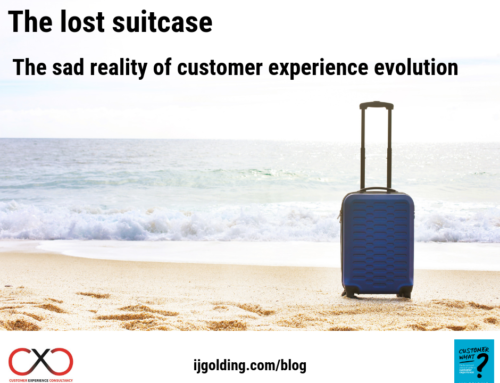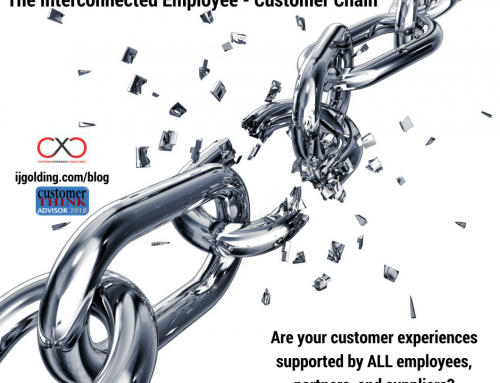As a consumer, there are occasions when I am interacting with an organisation that my heart genuinely sinks. There are times when I think to myself, ‘oh no – not again’. Sometimes I will even express my despair out loud. More often than not, the cause of my anguish is driven by poor customer service. Incompetence (employee behaviour) is another key factor. In fact the things that make my knees shake are perfectly summarised in the top 5 things that irritate us most as customers – https://ijgolding.com/2013/11/19/what-irritates-customers-most-the-top-five-irritations-revealed/- revealed in research I conducted late last year.
Number 5 on the list of ‘irritations’ is ‘poorly designed experiences’, and it is this irritation that I would like to focus on. It is an irritation that is increasingly rearing its head in our ever-changing fast paced virtualised world. As consumers, we expect the experiences we have to be as simple and easy to execute as possible. The reason why many organisations have started to consider ‘customer effort’ alongside ‘satisfaction’ and ‘likelihood to recommend’ is that there is growing recognition that the more complicated the customer will perceive their interaction with an organisation, the less likely it is that they will return.
When we consider the principle of ‘designing’ customer experiences, I often wonder whether businesses do actually design them for the benefit of the customer who will be the recipient of the experience. Whilst many experiences are very well-intentioned, it feels to me as though the organisation delivering them may never have actually ‘been through it’ themselves. How many times have you visited a hotel that has recently been renovated, only to discover that the plug sockets are nowhere near the bed? This infuriates me. Designing great experiences is often about getting the attention to detail spot on.
I like to remind people that all experiences are made up of three core components – components that the Customer Experience expert and my mentor, Bruce Temkin introduced to me a long time ago. The elements are:
- Functional – does the experience do what you want it to do?
- Accessible – how easy is it for you to do it?
- Emotional – how does it make you feel?
Many, although not all, organisations invest a lot of time and effort in getting the functional and accessible experience right. Few invest enough time and effort in the emotional element. However a focus on all three is essential if you have an ambition to consistently deliver customer experiences that do what customers want, as easily as possible leaving them to only remember just how easy and hassle free the experience was. If you do not consider these components when designing an experience, you will be at risk of delivering experiences that will fall short of customer expectation in some way. You could be at risk of irritating current and future customers.

This is where ‘Verified by Visa’ and the title of this blog post comes in. I remember when I first encountered the online security mechanism a few years ago. Designed to make online transactions in Europe more secure, retailers intentionally adopted the use of Verified by Visa to make consumers feel safer using their credit cards online. The official description of the system is as follows:
Verified by Visa protects your card against unauthorised use and gives you peace of mind when shopping online. Once you’ve signed up to Verified by Visa, you’ll be protected whenever you make an online payment with your Visa card at any one of more than 300,000 web sites across Europe
Sounds great – the intent is very clear – why wouldn’t you sign up? Whilst the intent is without doubt, the execution is very different. rather than giving me peace of mind, Verified by Visa is one of those things that makes my heart sink. As soon as I see the Verified by Visa logo, I sometimes consider whether I can be bothered attempting to complete the transaction at all. Verified by Visa is the perfect example of a mechanism that is designed with the best of intentions, but that makes the experience too difficult (and too much hassle) to carry out. The main issue is that I am not very good at remembering passwords. I am sure I am not alone. The older I get, the worse my memory becomes. Every time I interact with a company that uses Verified by Visa, I have to go through the process of re-setting my password – it is infuriating. I would not mind if it was easy to do – it is not. If you try to use Verified by Visa on an iPad, you cannot even see the characters correctly. Whoever created Verified by Visa, has either never used it, or does not care how complicated it is to use. Verified by Visa fails the ‘Accessible’ component of experience (in my opinion).
Have you ever considered why Amazon is so successful? It is not because of the ground breaking design of their website. It is not because they have the friendliest, most knowledgeable staff on the planet. It is because they are so good and consistent at getting the functional and accessible components of the experience right, all we remember is the satisfaction of how hassle free dealing with them is. Amazon do not use Verified by Visa. In fact Amazon are still the only retailer who can get you what you want with just one click of your mouse. As a famous Meerkat would say ‘simples’. Are we concerned that we do not have to go through a fifteen step (excuse the exaggeration!) verification process? No. We just want to do what we want as simply as possible.
Last week Mrs Golding wanted to purchase some clothes for our children online with River Island. Attracted by an email she had been sent, Naomi entered their website and spent an hour browsing and selecting a number of items. She was very impressed with the products on offer. Happy with her selection, Naomi made her way to the checkout. If she had been transacting with Amazon, one click later her transaction would have been complete. Two weeks later, and the transaction has not, and will not ever be completed.
The problem started when Naomi selected PayPal as the payment option. We will never quite understand whether it was down to River Island or PayPal – what we do know is that the website links just did not work. Having failed on that front, we selected the traditional ‘pay by credit card’ route. We spotted the Verified by Visa logo, and knew that it was coming. Naomi entered the correct characters for the password, even though she could not see them on the iPad screen. ‘Your password is incorrect’ flashed up in red on the screen. Naomi tried again – the same message was returned. Knowing that a third wrong answer might disable the card, I took over and entered my card details. The same message was returned. Try as we might, this well-intentioned process had made it impossible for us to complete the transaction.
The following day, whilst delivering a customer experience training course (in which I described our River Island experience), I received a message from Naomi despairing that our credit card had been blocked. As the primary card holder, I would have to phone the credit card provider to unblock it. Having waited four minutes listening to music, I was put through to an agent. The very nice man wanted me to quote two digits from my six digit password – I did not even know I had a six digit password!! To cut a very long story short, It took over forty minutes of blood sweat and tears to get the block removed on our credit card. What started as a desire to purchase some clothes from River Island ended in an emotional roller coaster. All I will remember from the experience is that shopping online with River Island is NOT EASY! If only Amazon sold River Island clothes!!
I wonder if the senior leadership team from River Island have actually been through the online shopping experience themselves. I wonder if they have compared their experience to the Amazon experience. If they did or had, they might be able to empathise with the experience we had. I am all for creating a secure trading environment – especially online, but it is important that it is done in a way that enhances the experience. Verified by Visa makes perfect sense if it does not make a transaction mind numbingly frustrating – you cannot excuse its poor design in the name of good security.
So the next time you consider the experience that your organisation delivers, or you act out your own experiences as a customer, consider whether or not the design of the experience is well intended or not. If it is not well intended, you have a problem. If it is well intended, that does not necessarily mean it meets the needs and wants of your customers. If your good intention is to the detriment of the functional, accessible or emotional components of your customer experience, you will need to consider re-designing the journey.








Is there a way one can free oneself of the dreaded Verified by Visa curse? I always have to pay my credit card by going into the Co op bank:crackers. But I can’t stand the hassle of V by V. And it’s not to do with my poor memory-I have each new password recorded in a notebook. They always refuse to acknowledge the latest,and I have to set up a new one. Then the time runs out…Honest,anyone who’d pinched my bag could get past it..although I can’t
Here in INDIA because RBI has made VbV compulsory, we cannot do transactions even with Visa Gold International Debit Card on International e-commerce webs like Google, PayPal and Amazon.com
Can you please suggest me a way out??
Haaaaattttteeee v v won’t shop on sites that require it Rejects .my card and tells me that my date of birth is wrong Spent wasted energy trying to purchase items and pay bill. I hate to see the DREADED V. v. Help its giving me nightmares
V by V on co-op bank card asked for password three times then locked me out got informed by co-op online operative it meant memorable name even though it clearly said Password and of course all the onus was put on me and i must have done things wrong even though i have been using V by V for years with other cards .
I absolutely hate this company. Over many years and many attempted payments, I have never been able to get past their bot. No company that wants to make international sales should ever install them on their site, ever.
Since Verified by Visa began I have been unable to buy anything on-line. There appears to be no way aroud it. This is because the Verified by Visa form asks for information which simly does not exist. It really is time we went back to cash and cheques.
Verified by Visa is deeply flawed.. Does it EVER work? I have had it fail for me on EVERY site (mostly airlines) that I have tired to use.. From many locations inside and outside the USA.. NO SITUATION in which it works, or any card, no matter how prestigious.